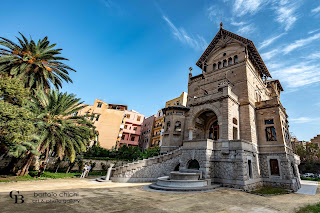Le bellezze dei borghi - The Beauty of the Villages - Monterosso Almo
Monterosso Almo è un comune del Libero consorzio comunale di Ragusa in Sicilia. In età normanna il borgo si chiamava Lupia (o Casal Lupino) per la presenza dei lupi; in età aragonese il suo nome era probabilmente Mons Almo (Monte Almo) o Johalmo. Dal conte Rosso di Messina che lo rifondò nel 1338 prese il nome di Mons Rubens, Monte Rosso. La realtà urbana vive d’aria salubre in posizione sicuramente privilegiata per fruire della somma bellezza dell’isola sicula, eterogenea terra di calura popolare e devozione religiosa incarnata nella consistente pletora di edifici religiosi a Monterosso preminenti.
Monterosso Almo imbocca la strada virtuosa della tutela e del restauro, ed è quindi pronto a mostrare al visitatore i suoi gioielli, a partire dalla vasta piazza San Giovanni, finalmente liberata dalle automobili, chiamata in dialetto u chianu, il piano, in rapporto con l’andamento a saliscendi del borgo, che segue le curve della montagna. Un lato della piazza è occupato dalla chiesa di San Giovanni Battista, posta su un terrazzamento naturale e al termine di un’ampia scalinata che le conferisce un aspetto fastoso e scenografico. Ricostruita dopo il terremoto del 1693, la chiesa – lievemente danneggiata dal sisma – ha una facciata barocca a tre ordini, scandita da un colonnato sul quale s’innesta la torre campanaria. L’interno è impreziosito dagli stucchi di Carmelo Fantauzzo di Grammichele, dalle piccole cappelle laterali e da due opere di artigianato locale, il pulpito di legno intagliato e la vara del santo protettore (1769). Gli altri lati della piazza sono occupati dal seicentesco palazzo dei baroni Noto e da tre edifici ottocenteschi e neoclassici: il municipio, Palazzo Sardo e il monumentale palazzo Cocuzza. A completare la piazza è la chiesa di Sant’Anna, appartenente ai frati minori riformati che l’inaugurarono nel 1652.
Monterosso si è sempre rivelata una paesana cenerentola ammantata di semplicità riscontrabile nel perseguire una cultura della terra fondata sugli antichi mestieri, l’agricoltura, la pastorizia e l’identità alimentare. gli anziani del luogo fanno da maestri alle nuove generazioni nella realizzazione di ricette culinerie davvero speciali che danno squisitamente adito a prelibatezze fatte in casa come il tipico pane di Monterosso nelle sue molteplici varianti (proposte sia alla Festa di Sant’Agata sia a quella di Santa Lucia), focacce (mpanate) biscotti fragranti e i succulenti cavatieddi (gnocchetti di pasta arrotolata rigorosamente con le dita e insaporita con sugo di maiale). Seguono nel menù la carne arrostita di cinghiale, maiale o agnello – u farsumauru – e la salsiccia. Dal territorio provengono i funghi, in autunno, e la cicerchia, legume alla base di una gustosa polenta.
Monterosso Almo is a commune of the Libero consorzio comunale di Ragusa in Sicily. In the Norman age the village was called Lupia (or Casal Lupino) because of the presence of wolves; in the Aragonese age its name was probably Mons Almo (Monte Almo) or Johalmo. Count Rosso of Messina, who refounded it in 1338, gave it the name Mons Rubens, Monte Rosso. The urban reality lives of salubrious air in a position certainly privileged to enjoy the sum beauty of the Sicilian island, heterogeneous land of popular heat and religious devotion embodied in the consistent plethora of religious buildings in Monterosso preeminent.
Monterosso Almo has embarked on the virtuous path of protection and restoration, and is therefore ready to show visitors its jewels, starting with the vast Piazza San Giovanni, finally freed from cars, called u chianu, the plain, in dialect, in relation to the up and downs of the village, which follows the curves of the mountain. One side of the square is occupied by the church of San Giovanni Battista, located on a natural terrace and at the end of a wide flight of steps that gives it a magnificent and scenic appearance. Rebuilt after the 1693 earthquake, the church - slightly damaged by the earthquake - has a Baroque façade with three orders, marked by a colonnade on which the bell tower is grafted. The interior is embellished with stucco work by Carmelo Fantauzzo of Grammichele, small side chapels and two works of local craftsmanship, the carved wooden pulpit and the coffin of the patron saint (1769). The other sides of the square are occupied by the 17th-century palace of the Barons Noto and three 19th-century neoclassical buildings: the Town Hall, Palazzo Sardo and the monumental Palazzo Cocuzza. Completing the square is the church of Sant'Anna, belonging to the reformed Friars Minor who inaugurated it in 1652.
Monterosso has always turned out to be a cinderella village cloaked in a simplicity found in the pursuit of a culture of the land based on ancient crafts, agriculture, sheep farming and food identity. The local elders are the masters of the new generations in the creation of very special culinary recipes that give rise to exquisite home-made delicacies such as the typical Monterosso bread in its many variations (offered at both the Sant'Agata and Santa Lucia festivals), fragrant focaccia (mpanate) biscuits and the succulent cavatieddi (small dumplings of pasta rolled up strictly with the fingers and flavoured with pork sauce). The menu also includes roast wild boar, pork or lamb - u farsumauru - and sausage. Mushrooms, in autumn, and chickling vetch, a legume used in a tasty polenta, come from the area.




Commenti
Posta un commento